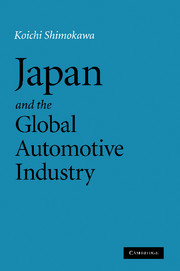Book contents
- Frontmatter
- Contents
- List of figures
- List of tables
- Preface
- Introduction
- 1 Comparing productivity of the Japanese and US automobile industries
- 2 The internationalization of the Japanese automotive industry and local production overseas
- 3 The recovery of European and US auto makers, and relocating and changing lean production
- 4 Early 1990s – the Japanese automotive industry loses international competitiveness, and the development of restructuring strategies
- 5 The restructuring of the global automotive and auto-parts industries
- 6 The restructuring of the world's auto-parts industry and the transfiguration of the keiretsu parts transaction
- 7 Global M&A and the future of the global auto industry – the light and dark sides of merger and re-alignment
- 8 The Asian and ASEAN automotive industries in the global era
- 9 China's automotive industry in the global era, Japanese auto makers, and their China strategies
- 10 Conclusion – the global automotive industry's perspective on the twenty-first century and tasks for the Japanese automotive industry
- Epilogue
- Index
- References
8 - The Asian and ASEAN automotive industries in the global era
Published online by Cambridge University Press: 06 July 2010
- Frontmatter
- Contents
- List of figures
- List of tables
- Preface
- Introduction
- 1 Comparing productivity of the Japanese and US automobile industries
- 2 The internationalization of the Japanese automotive industry and local production overseas
- 3 The recovery of European and US auto makers, and relocating and changing lean production
- 4 Early 1990s – the Japanese automotive industry loses international competitiveness, and the development of restructuring strategies
- 5 The restructuring of the global automotive and auto-parts industries
- 6 The restructuring of the world's auto-parts industry and the transfiguration of the keiretsu parts transaction
- 7 Global M&A and the future of the global auto industry – the light and dark sides of merger and re-alignment
- 8 The Asian and ASEAN automotive industries in the global era
- 9 China's automotive industry in the global era, Japanese auto makers, and their China strategies
- 10 Conclusion – the global automotive industry's perspective on the twenty-first century and tasks for the Japanese automotive industry
- Epilogue
- Index
- References
Summary
Introduction
As the automobile industry has become increasingly global, the rapidly growing industry in Asia has attracted attention. Asia is now recognized as a prospective growth region for the automobile industry in the twenty-first century, with its potential to be the world's largest automobile market given the huge population (1.4 billion in China, 0.8 billion in India, and 0.5 billion in Association of South-east Asian Nations (ASEAN) countries). The automobile markets in developed countries have reached maturity and have almost no growth potential.
However, although Asia has seen remarkable industrialization and economic growth from the 1980s onwards, steady progress is not always guaranteed – as seen during the currency crisis – and this holds equally true in the automobile industry. The South Korean automobile industry has an overproduction capacity of nearly 1 million cars annually, and automobile production in Thailand once reached 0.6 million per year, but declined by more than half due to the Baht crisis in July 1997.
During the economic crisis, most of the automobile manufacturers reduced production. Now there are signs that the financial order of the Asian region is starting to stabilize and recover. Japanese, European, and US automobile manufacturers have started to increase production in the region again. Sooner or later, it is expected that the automobile industry in Asia will be revived.
- Type
- Chapter
- Information
- Japan and the Global Automotive Industry , pp. 230 - 259Publisher: Cambridge University PressPrint publication year: 2010



